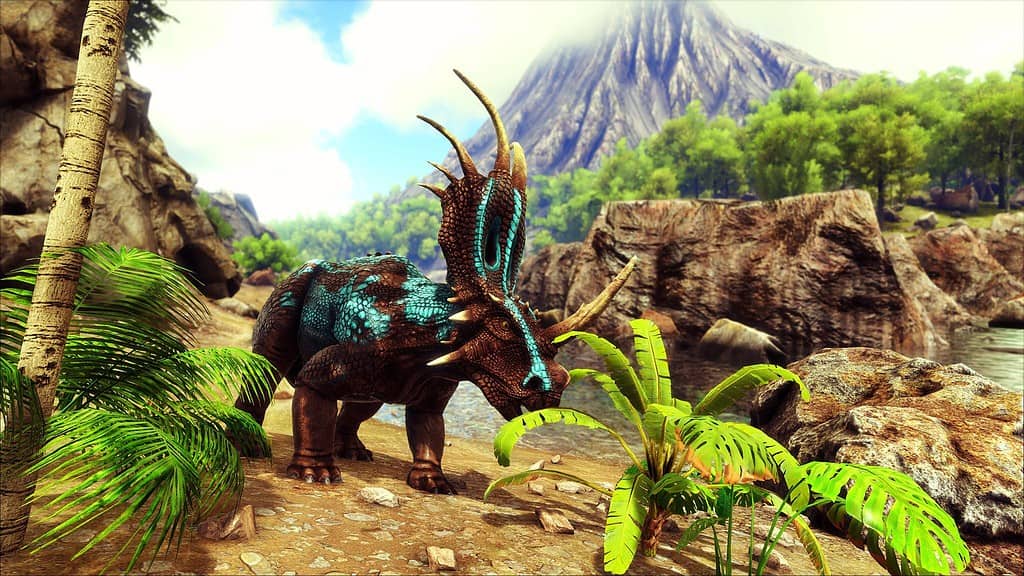Styracosaurus (let me help, sti-RAK-ə-SOR-əs) is a ceratopsian dinosaur from Late Cretaceous North America. This dinosaur is notable for its unique head ornamentation: a large frill with spikes and a prominent nose horn. It was basically a one-horn Triceratops. Its menacing appearance earned this dinosaur the name Styracosaurus, “The Spiked Lizard”.
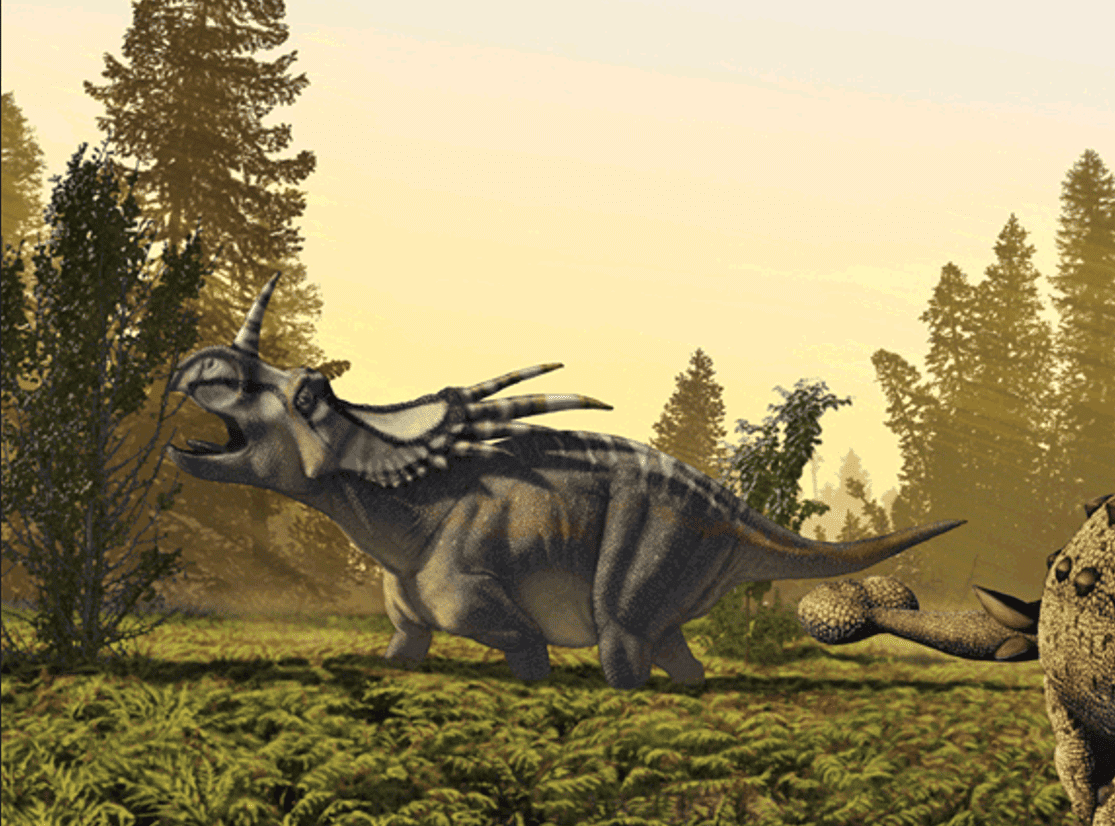
Discovery and History
Styracosaurus‘ story begins in the rugged terrains of Alberta, Canada, when it was first unearthed in 1913 by American-Canadian paleontologist C. M. Sternberg. The site was part of the richly fossiliferous Dinosaur Park Formation, known today as Dinosaur Provincial Park. However, it was Lawrence Lambe who described these initial findings, thus introducing Styracosaurus albertensis to the scientific community. This specimen showcased the dinosaur’s distinctive frilled neck adorned with spikes.
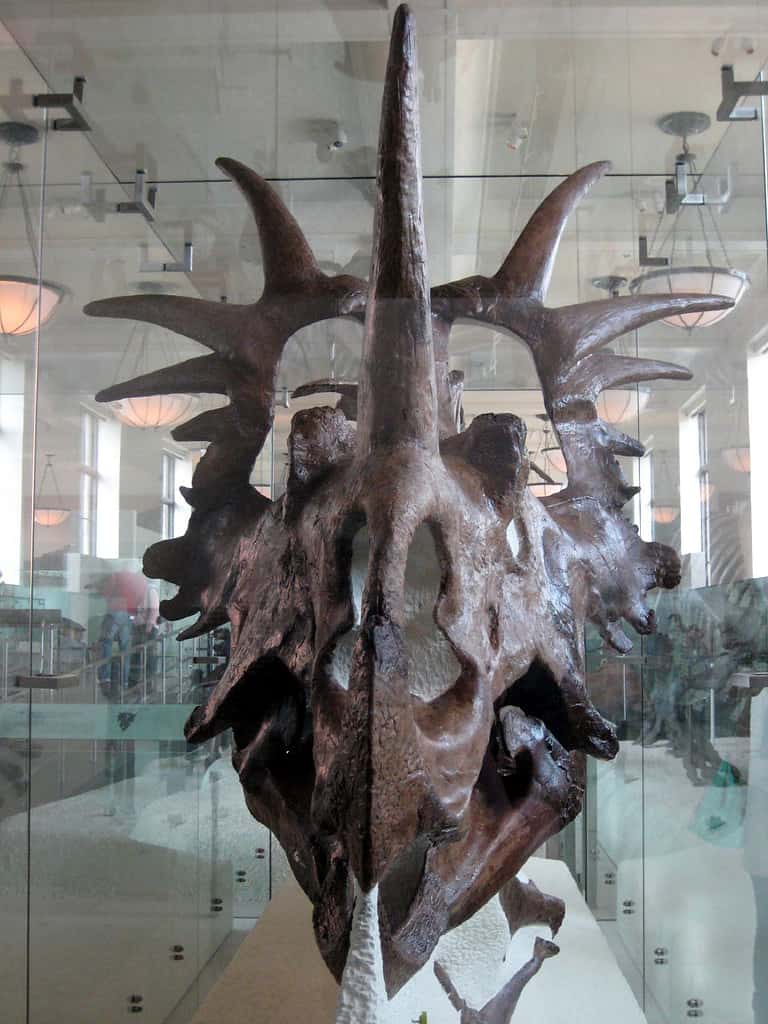
Further expeditions to the region unearthed more complete skeletons, including lower jaws that had been missing. Another significant discovery came from Barnum Brown‘s team in 1915 near Steveville, Alberta. The team excavated a nearly complete skeleton that Brown and Erich Maren Schlaikjer later named Styracosaurus parksi, honoring the legendary paleontologist William Parks. However, the distinction would not last. In light of new findings, paleontologists later realized this specimen wasn’t a new species, and has since been reclassified as S. albertensis.
This would prove to be a recurring theme. Over the years, various other species have been attributed to Styracosaurus, only for some to be reassigned to other genera. In one extraordinary case, the Styracosaurus ovatus specimen, discovered in Montana by Charles Gilmore, was reassigned to a new genus, Rubeosaurus.
Styracosaurus is part of the diverse lineage of ceratopsians. It was a distant cousin to the more famous Triceratops. Going down the phyllogenetic tree, Styracosaurus belongs to the Centrosaurinae subfamily, which are all characterized by their distinctive horns and frills.
Description and Anatomy

Styracosaurus was a large centrosaurine ceratopsian, approximately 5 to 5.5 meters long and weighing around 2 metric tons. Its body was robust and heavily built, similar to modern rhinoceros. The dinosaur stood about 1.8 meters tall, showcasing a bulky quadrupedal frame. Styracosaurus possessed short, powerful forelimbs and longer hindlimbs, ending in hoof-like claws. While not the fastest dinosaur, Styracosaurus could move effectively across the diverse terrains of its ecosystem.
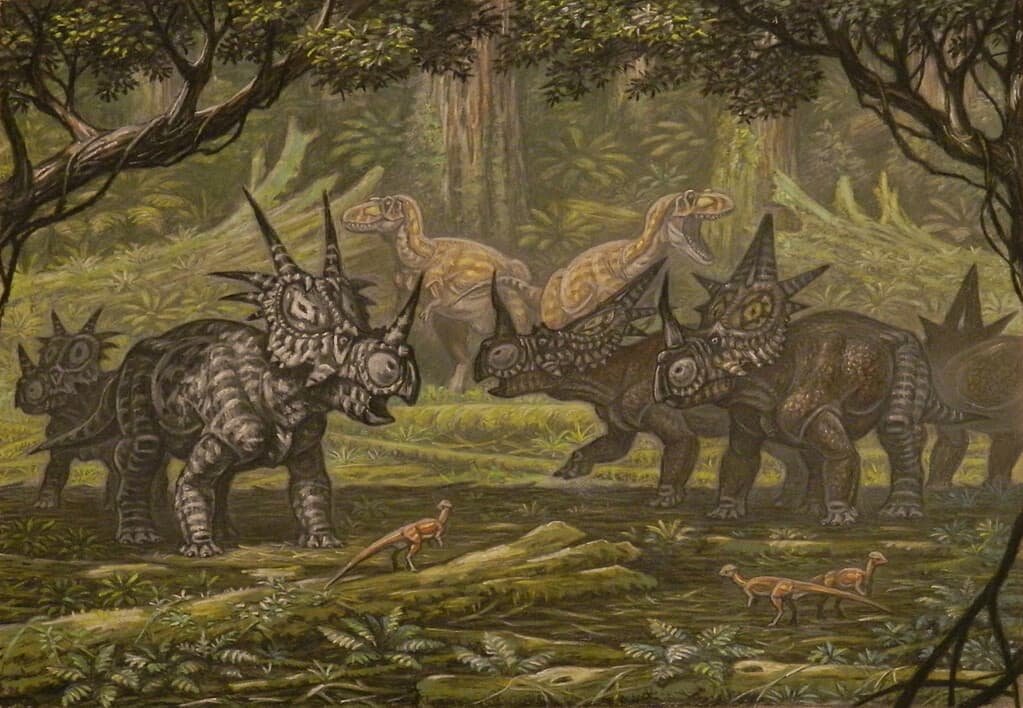
Styracosaurus’ skull was massive and sported a pronounced nose horn, which could grow up to 60 centimeters long. This horn was accompanied by four to six long neck frill spikes, each measuring up to 55 centimeters long. The arrangement and size of these spikes could vary among individuals, contributing to the distinct appearance of each Styracosaurus.
Paleontologists still debate the role of these frills. This bony structure protected the neck and possibly served as a display feature to attract mates or deter rivals. The frill’s edges were adorned with smaller projections and knobs, varying greatly in size among individuals. This variation suggests a potential role in species or individual recognition.

Equipped with a beak-like mouth and shearing cheek teeth, Styracosaurus was herbivorous. Its teeth were arranged in continuous dental batteries, ideal for chewing tough, fibrous plants. This adaptation indicates Styracosaurus fed on various types of plants such as ferns, cycads, and early flowering plants.
Paleobiology and Behavior
Evidence suggests Styracosaurus may have been a social animal, possibly moving in herds. The discovery of bone beds containing the remains of multiple individuals suggests Styracosaurus traveled in groups. The the very least, they probably congregated at certain times of the year. Such social structures could have offered protection against predators, facilitated mating, and helped in caring for the young.
While specific details of Styracosaurus‘ reproductive behavior remain speculative, scientists assume that, like other ceratopsians, it laid eggs. The growth from hatchling to adult involved significant changes in horn and frill development.
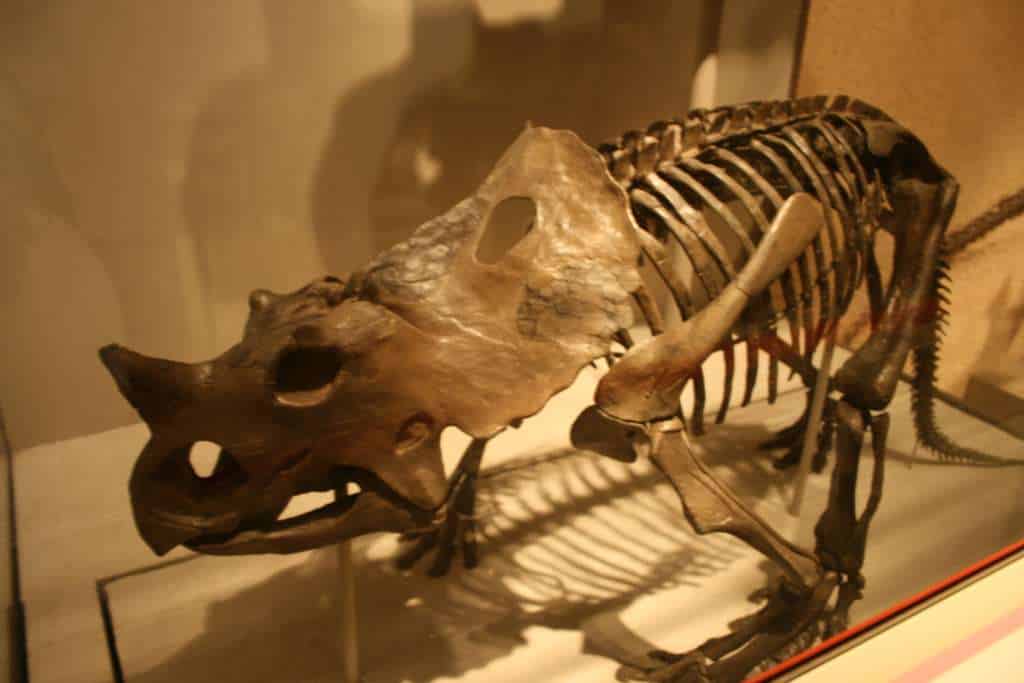
Styracosaurus‘ prominent horns and frill likely served multiple purposes, including defense against predators. The nose horn and frill spikes could have been used as weapons in confrontations with carnivorous dinosaurs. Additionally, the frill’s visual display might have served as intimidation to deter predators by making Styracosaurus appear larger. These physical adaptations suggest that visual signals play a significant role in communication within the species. The variation in horn and frill morphology could have been crucial for individual recognition, establishing social hierarchy, and attracting mates during breeding seasons.
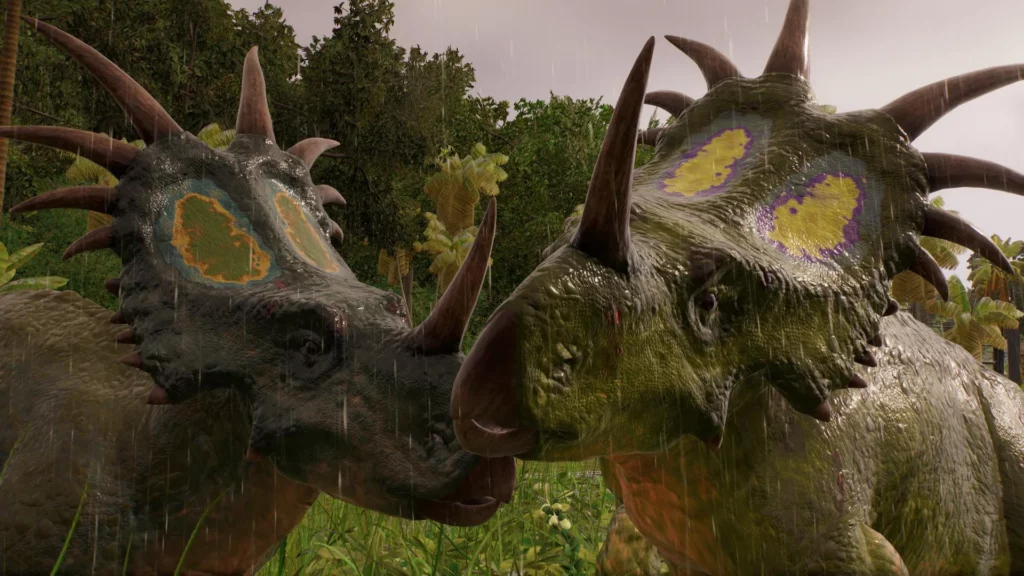
Paleoecology
Styracosaurus inhabited the diverse ecosystems of Late Cretaceous North America, primarily within the Dinosaur Park Formation in Alberta, Canada. This region presented a landscape characterized by river valleys, floodplains, and ancient forests, under a much warmer climate than today’s. The rich plant life supported a wide array of herbivorous dinosaurs, and Styracosaurus likely thrived.
The Dinosaur Park Formation was a hub of dinosaur diversity, housing various other dinosaur families. Tyrannosaurids such as Gorgosaurus and Daspletosaurus roamed the same areas, posing a constant threat to the herbivores, even large ones like Styracosaurus. The presence of these apex predators suggests that the defensive features of Styracosaurus, such as its mighty horn and frills, played a crucial role in its survival strategies.
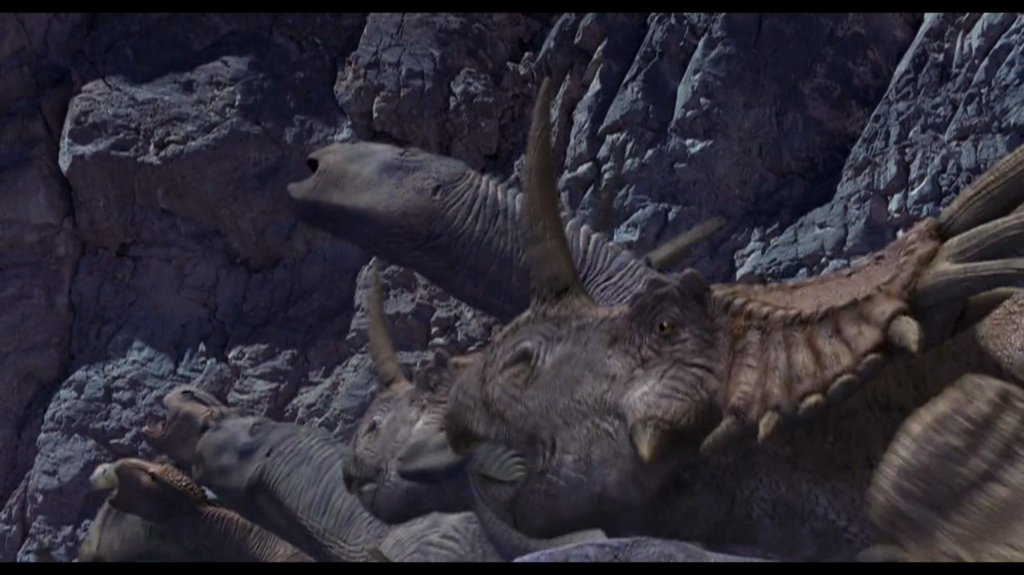
In addition to the carnivores, Styracosaurus also shared its environment with hadrosaurs like Corythosaurus and Lambeosaurus, as well as fellow ceratopsians like Centrosaurus. These species likely competed for resources, yet the diversity of plant life may have allowed for niche partitioning, reducing direct competition.
Styracosaurus in Popular Culture
Although it didn’t see as much screen time as Triceratops, Styracosaurus is no stranger to popular culture appearances.

The animated series “The Terrible Thunderlizards” features Kutter, the Styracosaurus, a member of a trio tasked with eliminating two human characters. Kutter, often seen wielding an arsenal of weapons, adds a comedic touch to the depiction of dinosaurs. Despite the humorous context, his character maintains the distinctive features of Styracosaurus, including the spiked frill and horn, making him recognizable to fans of the species.
In Disney’s “Dinosaur” (2000), Styracosaurus is represented by a character named Eema. Eema is an older, somewhat weary dinosaur but with a resilient spirit. She befriends Aladar, the film’s protagonist, and his lemur family, joining them in their dangerous journey across a ravaged landscape to find a new home. Her character is wise and provides comic relief when situations are getting grim. Eema’s best friend is an old Brachiosaurus named Baylene.

In the video game “Jurassic Park: Operation Genesis”, and subsequently “Jurassic World Evolution”, players can create and manage their own dinosaur theme park. Styracosaurus is among the species available for players to breed and exhibit. The games highlight the dinosaur’s distinctive anatomy and behaviors, allowing players to interact with it in a simulated natural environment.
Pixar’s “The Good Dinosaur” features a Styracosaurus character named Forrest Woodbush, who is a quirky collector of various animals he uses for protection. While significantly anthropomorphized, Forrest Woodbush’s design incorporates the recognizable frill and horns of Styracosaurus.
The survival game “ARK: Survival Evolved” includes Styracosaurus as one of the tamable and rideable dinosaurs. Players encounter it within the game’s expansive open world, where it is depicted with its trademark spikes and horn, used for both defense and as a mount.
